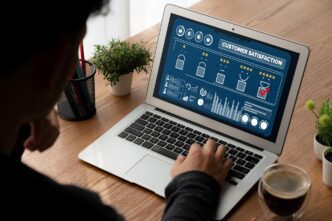Executive Summary
The Story So Far
Why This Matters
Who Thinks What?
Small businesses are increasingly recognizing that data is not merely the domain of large enterprises but a critical asset for their own growth and sustainability. Data visualization tools empower these agile operations to transform raw, often overwhelming, datasets into clear, actionable insights, enabling owners and managers to make informed decisions swiftly and strategically. By presenting complex information visually through charts, graphs, and interactive dashboards, these tools democratize data analysis, allowing even those without a dedicated data science team to uncover trends, optimize operations, understand customers, and identify new market opportunities, ultimately fostering a competitive edge in today’s data-driven landscape.
The Imperative of Data for Small Businesses
In the digital age, every transaction, website visit, social media interaction, and inventory movement generates valuable data. For small businesses, this wealth of information holds the key to understanding performance, predicting future outcomes, and adapting to market changes.
However, raw data in spreadsheets or disparate systems can be daunting and difficult to interpret. Without proper analysis, these insights remain locked away, preventing businesses from leveraging their full potential.
This is where data visualization becomes indispensable, acting as the bridge between raw numbers and strategic action.
What is Data Visualization?
Data visualization is the graphical representation of information and data. By using visual elements like charts, graphs, and maps, data visualization tools provide an accessible way to see and understand trends, outliers, and patterns in data.
It translates complex datasets into digestible, intuitive visuals, making it easier to identify relationships and draw conclusions that might be missed in a table of numbers.
Effective data visualization tells a story with data, allowing stakeholders to grasp insights quickly and efficiently.
Key Benefits for Small Businesses
Adopting data visualization tools offers a multitude of advantages that directly impact a small business’s bottom line and strategic direction.
Enhanced Decision-Making
Visualizing data allows business owners to quickly identify trends, patterns, and anomalies that influence their operations. This enables a shift from intuition-based decisions to strategies grounded in concrete evidence.
For instance, a sales chart can immediately highlight seasonal peaks and troughs, informing staffing and inventory decisions.
Improved Operational Efficiency
By visualizing operational data, businesses can pinpoint inefficiencies and bottlenecks. This could involve optimizing supply chain logistics, refining inventory management, or improving staff scheduling based on real-time demand.
Visual dashboards can track key performance indicators (KPIs) for various departments, ensuring continuous improvement.
Deeper Customer Understanding
Data visualization helps small businesses segment their customer base, analyze purchasing habits, and understand demographic trends. This deeper insight allows for more personalized marketing campaigns and improved customer service strategies.
Understanding customer journeys through visual maps can reveal critical touchpoints for engagement and retention.
Identification of New Opportunities
Visualizing market data, competitor analysis, and customer feedback can uncover unmet needs or emerging market trends. This proactive approach allows small businesses to innovate, develop new products or services, and expand into profitable niches.
Spotting a gap in local service offerings, for example, can be much clearer when geographic data is mapped visually.
Better Performance Monitoring
With interactive dashboards, small businesses can monitor their performance against goals in real-time. This immediate feedback loop allows for agile adjustments to marketing campaigns, sales strategies, or operational processes.
Tracking website traffic, conversion rates, or social media engagement visually provides an instant snapshot of success and areas needing attention.
Essential Features to Look for in Data Visualization Tools
When selecting a data visualization tool, small businesses should prioritize features that align with their specific needs and resource constraints.
Ease of Use and Intuitive Interface
Since small businesses often lack dedicated data analysts, a tool with a user-friendly interface is paramount. Look for drag-and-drop functionality, pre-built templates, and clear navigation that minimizes the learning curve.
The ability for non-technical users to create meaningful visualizations without extensive training is a significant advantage.
Affordability and Scalability
Budget constraints are a reality for most small businesses, making cost-effective solutions crucial. Many tools offer tiered pricing, freemium models, or affordable subscription plans that can scale as the business grows.
Ensure the tool can handle increasing data volumes and evolving analytical needs without prohibitive costs.
Data Connectivity
A good data visualization tool should seamlessly connect to various data sources common to small businesses. This includes spreadsheets, CRM systems, e-commerce platforms, social media analytics, and accounting software.
Robust integration capabilities ensure all your disparate data can be brought together for a holistic view.
Variety of Visualization Types
The tool should offer a wide array of chart and graph types to suit different data stories. This includes bar charts, line graphs, pie charts, scatter plots, and geographical maps.
Having diverse options ensures you can choose the most effective visual representation for your particular insight.
Dashboarding Capabilities
The ability to create interactive and customizable dashboards is vital. Dashboards consolidate multiple visualizations into a single view, providing a comprehensive overview of key metrics.
Users should be able to filter, drill down, and interact with the data to explore different facets of the business.
Collaboration Features
The ability to easily share dashboards and reports with team members, stakeholders, or clients is essential for fostering a data-driven culture. Look for features that allow secure sharing, commenting, and version control.
Collaborative tools ensure that insights are disseminated efficiently and contribute to collective decision-making.
Leading Data Visualization Tools for Small Businesses
Several tools stand out for their accessibility, features, and suitability for small business needs.
Microsoft Power BI
Microsoft Power BI is a powerful business intelligence tool that offers robust data visualization capabilities. It integrates seamlessly with the Microsoft ecosystem, making it a strong choice for businesses already using Excel or other Microsoft products.
While it has a free desktop version, advanced features and collaboration require a paid subscription, which remains highly competitive.
Google Looker Studio (formerly Google Data Studio)
Google Looker Studio is a free, web-based tool that excels at integrating with other Google products like Google Analytics, Google Ads, and Google Sheets. It’s incredibly user-friendly for creating interactive dashboards and reports.
Its ease of sharing and zero cost make it an excellent entry point for small businesses, though its advanced analytical features are less extensive than Power BI or Tableau.
Zoho Analytics
Part of the broader Zoho suite, Zoho Analytics is a self-service business intelligence and data analytics platform. It offers extensive data connectivity, a wide range of visualization options, and strong dashboarding capabilities.
Its affordable pricing and integration with other Zoho applications make it a compelling option for businesses already within the Zoho ecosystem or those seeking an all-in-one solution.
Canva
While not a traditional BI tool, Canva is invaluable for small businesses needing to create visually appealing infographics, charts, and presentations for marketing or internal communication. Its intuitive drag-and-drop interface and vast template library make it easy to design professional-looking visuals with minimal effort.
For simple data representation and design-focused needs, Canva provides an accessible and effective solution.
Implementing Data Visualization: Best Practices
To maximize the impact of data visualization, small businesses should follow a few key best practices.
First, start with clear objectives: define the specific business questions you want to answer before building any visualization. Second, identify key metrics that truly matter to your goals, avoiding the temptation to visualize every piece of data.
Third, keep visualizations simple and uncluttered, prioritizing clarity and ease of understanding over complex designs. Finally, iterate and refine your dashboards as your business needs evolve, and train your team to ensure widespread adoption and understanding of the insights presented.
Embracing data visualization tools is no longer a luxury but a strategic necessity for small businesses looking to thrive in a competitive marketplace. These tools demystify complex data, providing clear pathways to informed decisions, operational excellence, and sustainable growth. By leveraging accessible and powerful visualization platforms, small businesses can unlock the full potential of their data, gaining the insights needed to adapt, innovate, and lead.








